Ten gentle exercises can help you manage anxiety while building physical wellness. Start with walking in nature, which naturally reduces stress hormones, or try gentle stretching to release tension. Swimming offers a calming sanctuary while providing full-body movement, and mindful yoga connects your breath with basic poses. Low-impact dance lets you move freely without pressure, while Tai Chi's flowing movements promote balance. You can also try gardening, casual bike riding, or water aerobics at your own pace. These activities work even better when combined with mindful breathing techniques. Discovering the right combination of these gentle exercises will reveal your path to both physical and emotional well-being.
Walking in Nature

Starting with a gentle stroll through natural surroundings, walking in nature offers an accessible way to ease anxiety while building physical fitness. You'll find that spending time outdoors helps reduce stress hormones while increasing feel-good chemicals in your brain. Natural settings like parks, forests, or beaches provide a calming backdrop that can help quiet racing thoughts.
Begin with short 10-15 minute walks and gradually increase your duration as you build confidence. You don't need special equipment – just comfortable shoes and weather-appropriate clothing. Consider walking during off-peak hours if you're concerned about crowds, and choose well-maintained paths that feel safe and familiar.
As you walk, focus on engaging your senses: notice the rustling leaves, feel the breeze on your skin, and breathe in the fresh air. This mindful approach helps anchor you in the present moment, reducing anxiety-driven thoughts about the past or future.
You can also invite a trusted friend to join you, combining the benefits of exercise with social support. Remember to maintain a comfortable pace that allows you to breathe easily and enjoy the experience without feeling overwhelmed.
Gentle Stretching
Through gentle stretching, you'll discover a powerful way to release physical tension that often accompanies anxiety. Start by finding a quiet space where you can move freely without distractions. You don't need special equipment – just comfortable clothes and a yoga mat or soft surface.
Focus on your breath as you perform these anxiety-reducing stretches. Hold each position for 15-30 seconds while breathing deeply. If you feel pain, ease back immediately – stretching should feel soothing, not uncomfortable.
| Stretch Name | Emotional Benefit |
|---|---|
| Child's Pose | Creates feelings of safety and comfort |
| Neck Rolls | Releases worry and mental burden |
| Cat-Cow Flow | Promotes emotional flexibility |
| Forward Fold | Calms racing thoughts |
| Butterfly Pose | Opens heart and reduces fear |
Remember to move slowly and mindfully through each stretch. You'll notice your muscles gradually relaxing as anxiety symptoms decrease. When you're finished stretching, take a moment to observe how your body feels – you'll likely experience a sense of lightness and mental clarity that wasn't there before.
Swimming at Your Pace
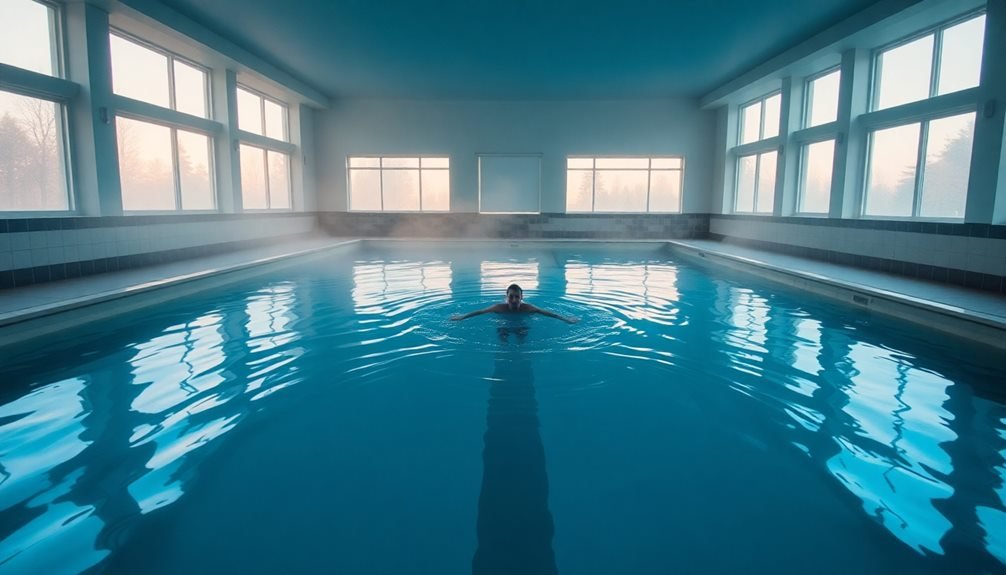
The gentle ripples of water can provide a natural sanctuary for anxious minds. Swimming offers a low-impact, full-body workout that lets you control the intensity while staying connected to your breath. You'll find that the rhythmic nature of swimming strokes can help quiet racing thoughts and promote mindfulness.
Start by choosing a quiet time at your local pool when it's less crowded. You don't need to dive right in – begin by walking in the shallow end or sitting on the pool steps to acclimate yourself to the water's temperature and sensation.
Once you're comfortable, try floating on your back, focusing on your breathing and the water's gentle support. As you progress, incorporate basic strokes like the breaststroke or backstroke, which allow you to maintain steady breathing patterns.
Don't worry about speed or distance – focus instead on smooth, controlled movements. If you're new to swimming, consider taking beginner lessons during off-peak hours. The instructor can help you develop proper form while respecting your comfort level.
Remember to always listen to your body and take breaks when needed.
Mindful Yoga
While many people associate yoga with complex poses and flexibility, mindful yoga focuses on gentle movements that unite breath with basic stretches.
You'll find this form of yoga particularly helpful for anxiety, as it emphasizes staying present in your body rather than perfecting difficult positions.
Start with simple poses like child's pose, cat-cow stretches, and gentle forward folds. As you move through each position, focus on your breath and how your body feels. You don't need to hold poses for long – even 30 seconds can be beneficial when you're first starting out.
When practicing mindful yoga, you'll want to find a quiet space where you won't be interrupted. Lay down a yoga mat or soft blanket, and wear comfortable clothes that allow you to move freely.
If you're unsure about proper form, you can follow along with beginner-friendly yoga videos or join a gentle yoga class where instructors can guide you.
Low-Impact Dance
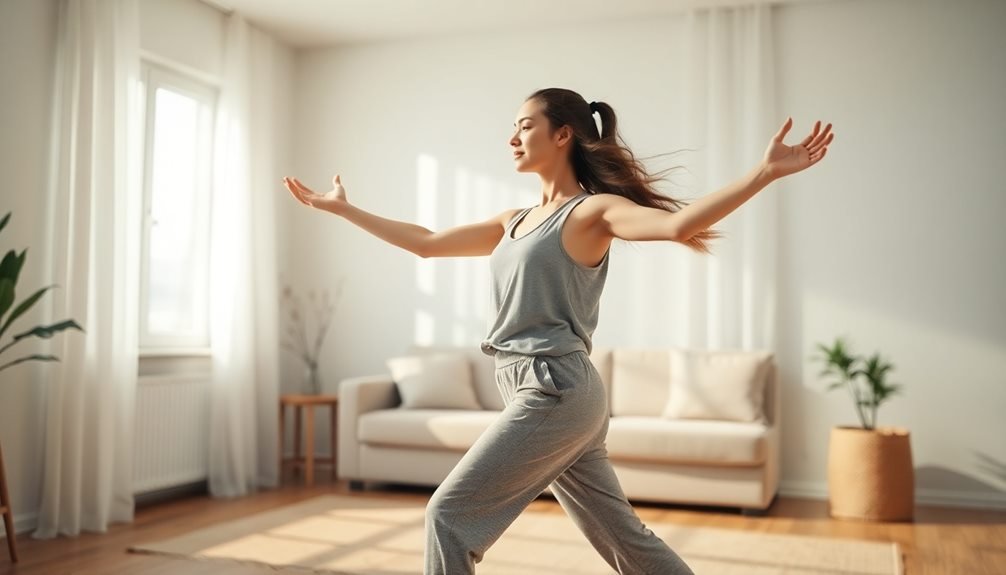
Dancing up and down to your favorite music offers a natural way to reduce anxiety without feeling like you're exercising. You don't need special equipment or training to start moving your body to rhythmic beats. Low-impact dance movements are gentle on your joints while still providing enough movement to release endorphins and reduce stress hormones. You can dance in your living room, bedroom, or any space where you feel comfortable and safe.
For the best anxiety-reducing dance experience:
- Start with slower songs that have steady, predictable rhythms – this helps you maintain control and build confidence in your movements.
- Keep your movements small and controlled, focusing on swaying, stepping side-to-side, or gentle arm movements rather than jumping or spinning.
- Listen to music that makes you feel good and brings back positive memories – your playlist should lift your mood, not trigger anxious thoughts.
- Dance for just 10-15 minutes at first, gradually increasing your session length as you become more comfortable with the movement.
Remember to breathe naturally and stay within your comfort zone while dancing. If you feel overwhelmed, slow down or take a break.
Deep Breathing While Walking
Syncing your breath with each step during a casual walk can help regulate your anxiety and develop mindfulness.
You'll find that matching your inhales and exhales to your walking rhythm creates a natural, calming pattern that's easy to maintain.
This simple breathing technique while walking not only clears your mind but also helps you stay focused on the present moment rather than worrying about future concerns.
Breathe With Each Step
As you walk at a comfortable pace, coordinating your breath with your steps creates a natural, calming rhythm that can ease anxiety. This simple technique helps you focus on the present moment while maintaining a steady walking pattern that matches your breathing.
You'll find that synchronizing these movements brings your mind and body into harmony, reducing stress and promoting relaxation.
To practice step-breathing effectively:
- Begin by inhaling slowly through your nose for two steps, letting your belly expand naturally as you breathe in.
- Hold your breath gently for one step, keeping your movements fluid and natural.
- Exhale slowly through your mouth for four steps, feeling tension release with each exhale.
- Pause briefly for one step before starting the next breath cycle.
You don't need to maintain this pattern rigidly – adjust the number of steps for each breath phase to match your comfort level.
If you're walking uphill or at a faster pace, you might need shorter breathing cycles. The key is finding a rhythm that feels natural and sustainable for you, allowing your mind to settle into the soothing pattern of breath and movement.
Benefits For Mental Clarity
Practicing deep breathing while walking offers powerful benefits for mental clarity. When you combine mindful walking with controlled breathing, you'll notice an immediate calming effect on your racing thoughts. This simple practice helps your brain shift away from anxious thinking patterns and allows you to focus on the present moment.
You'll find that coordinating your breath with your steps creates a natural rhythm that can break the cycle of overthinking. The increased oxygen flow to your brain enhances your ability to think clearly and make decisions with greater confidence.
As you maintain this walking-breathing pattern, you're actually training your mind to process information more efficiently. This practice also strengthens your ability to concentrate throughout the day.
You'll discover that the skills you develop during these walking sessions transfer to other activities, helping you stay focused during work or study. The combination of gentle movement and controlled breathing triggers the release of endorphins and reduces stress hormones, creating ideal conditions for mental clarity.
Over time, you'll build a stronger connection between your physical movement and mental state, leading to better emotional regulation.
Tai Chi Basics
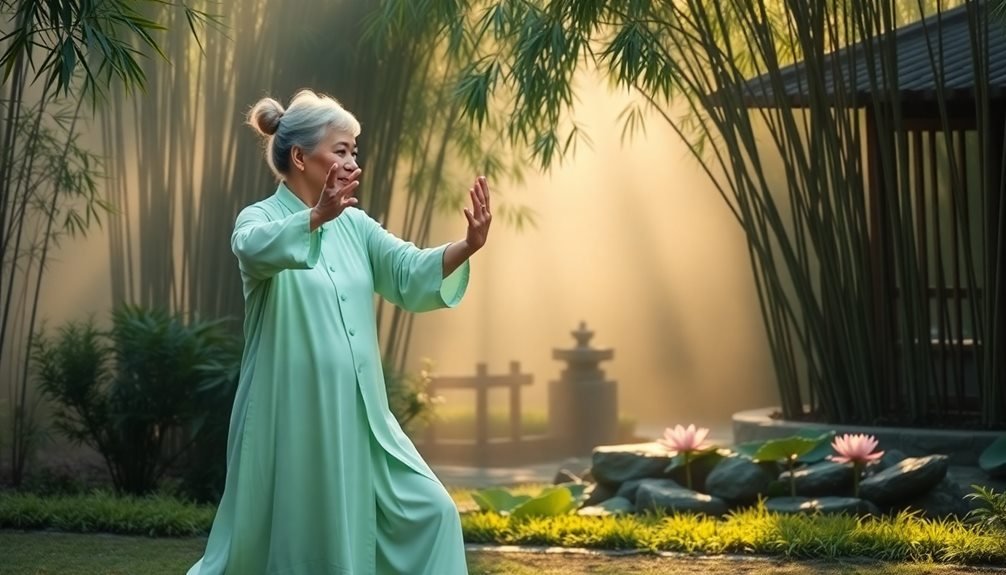
You'll find Tai Chi particularly calming with its flowing movements that gently shift from one pose to another.
By linking each motion with conscious breathing, you're building a natural rhythm that helps clear your mind while improving stability.
As you practice maintaining your balance through these gentle poses, you'll develop both physical and emotional steadiness that can help manage anxiety symptoms.
Easy Flowing Movements
Tai chi's gentle, flowing movements provide an ideal starting point for anxiety sufferers new to exercise. You'll find these continuous, circular motions help calm your mind while improving balance and coordination.
As you practice, you'll notice your breathing naturally becomes deeper and more rhythmic, which helps reduce stress and anxiety symptoms.
When starting your tai chi practice, focus on these fundamental flowing movements:
- Wave Hands Like Clouds – Stand with feet shoulder-width apart, shifting weight from side to side while moving your arms in gentle circular motions, as if parting clouds.
- Brush Knee and Push – Step forward while one hand "brushes" past your knee and the other hand pushes forward, creating a smooth, defensive motion.
- Grasp Bird's Tail – Perform a series of gentle pushing and pulling movements while shifting your weight, improving balance and core strength.
- Single Whip – Extend one arm while turning your body, moving as if slowly unfurling a whip, enhancing flexibility and coordination.
Remember to keep your movements slow, deliberate, and continuous.
Don't worry about perfection – focus instead on maintaining a smooth, steady flow that feels comfortable for your body.
Mindful Breathing Techniques
Learning to breathe mindfully forms the foundation of any tai chi practice. By focusing on your breath, you'll naturally calm your mind and reduce anxiety while preparing your body for gentle movement.
Start by standing or sitting comfortably, allowing your shoulders to relax and your spine to lengthen naturally.
Practice the "bamboo breathing" technique by imagining you're a hollow bamboo stem. Inhale slowly through your nose, feeling the breath move from your lower abdomen up through your chest. As you exhale through slightly parted lips, let the breath flow down like water through the bamboo. Count to four as you inhale, hold for two counts, then exhale for six counts.
You'll want to coordinate this breathing pattern with your tai chi movements. When lifting or expanding movements occur, inhale. When lowering or contracting movements happen, exhale.
If you feel dizzy or light-headed, return to your normal breathing pattern. Remember, there's no need to force deep breaths – instead, let them develop naturally as you practice. Your breath should remain smooth, continuous, and relaxed throughout your practice session.
Find Your Balance
Once you've established a comfortable breathing rhythm, mastering basic balance techniques becomes your next step in tai chi practice.
Standing with your feet shoulder-width apart, focus on distributing your weight evenly between both feet. Feel your connection to the ground as you slowly shift your weight from side to side, maintaining awareness of your body's position in space.
As you practice tai chi for anxiety management, you'll want to incorporate these fundamental balance exercises into your routine:
- Single-leg stands: Lift one foot slightly off the ground while keeping your other leg straight, hold for 10 seconds, then switch sides
- Cloud hands: Move your arms in slow, flowing circles while gently transferring weight between your feet
- Forward-backward weight shifts: Rock your weight from heel to toe while keeping your upper body aligned
- Box step: Draw an imaginary square with your feet, stepping deliberately to each corner while maintaining steady breathing
Remember to keep your movements slow and deliberate, allowing your mind to focus solely on your balance and positioning.
If you feel unsteady, it's perfectly fine to practice near a wall for support.
Simple Garden Activities
Regularly spending time in the garden provides a perfect low-impact way to ease anxiety while connecting with nature.
You'll find that simple activities like pulling weeds, planting seedlings, or raking leaves can help ground you in the present moment while gently exercising your body.
Start with 10-15 minutes of light gardening tasks, focusing on your breathing as you work. When you're watering plants, pay attention to how the water flows and the fresh scent of damp soil.
While pruning or deadheading flowers, notice the different textures and colors around you. These mindful movements help reduce stress while strengthening your core and improving flexibility.
If you're new to gardening, begin with container plants or a small herb garden. You don't need a large space – even tending to windowsill plants can provide therapeutic benefits.
Try alternating between standing and kneeling activities to engage different muscle groups without overexertion. Remember to wear comfortable clothes, use proper tools, and take breaks when needed.
The key is to move at your own pace while enjoying the calming effects of nurturing living things.
Casual Bike Riding
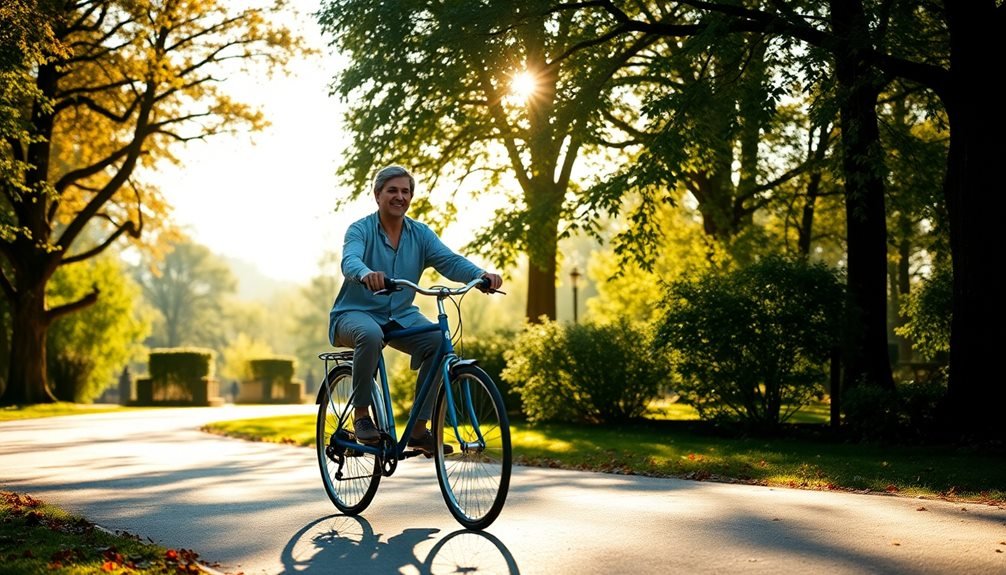
When you're starting to bike ride with anxiety, it's best to stick to familiar neighborhood routes where you'll feel secure and comfortable.
You can gradually build confidence by beginning with short, 10-15 minute rides around your local streets.
Keep your pace relaxed and manageable, focusing on steady pedaling rather than speed or distance goals.
Choose Neighborhood Routes First
To minimize anxiety during your early bike rides, stick to familiar streets in your own neighborhood. You'll feel more confident knowing the traffic patterns, road conditions, and potential rest stops along these routes.
Starting in a familiar area lets you focus on getting comfortable with your bike rather than worrying about navigation or unexpected situations.
When choosing your neighborhood routes, look for streets with minimal traffic and good visibility. You'll want to map out paths that connect to parks, quiet residential areas, or dedicated bike paths where possible.
It's also helpful to identify a few different route options varying in length and difficulty.
- Start with a simple 10-15 minute loop around your immediate blocks where you can easily return home if needed.
- Pick routes with gradual inclines rather than steep hills until you build confidence.
- Note safe places to stop and rest, like parks or benches, along your chosen paths.
- Identify streets with wide shoulders or bike lanes for added security.
As you become more comfortable with these familiar routes, you can gradually expand your riding territory and explore new areas.
Start With Short Distances
Easing up and out on a bike starts with manageable distances that won't overwhelm you. Begin with short rides of just 10-15 minutes around your neighborhood, focusing on staying relaxed and building confidence rather than covering long distances. You'll find it's easier to manage anxiety when you're not pushing yourself too hard initially.
Set small, achievable goals for each ride. Start by cycling to the end of your street and back, then gradually extend your route by adding one or two blocks at a time. If you're feeling particularly anxious, it's perfectly fine to turn around and head home – you can try again tomorrow.
Keep track of your progress in a simple journal or smartphone app, noting both distance and how you felt during the ride.
As your comfort level increases, you can slowly expand your riding time to 20-30 minutes. Don't rush this progression – there's no set timeline for increasing your distance.
Remember to check your bike's condition before each ride, ensuring your tires are properly inflated and your brakes are working well. This helps reduce any anxiety about mechanical issues while you're out.
Keep a Comfortable Pace
Beginners often feel pressured to match the speed of other cyclists, but maintaining your own comfortable rhythm is essential when managing anxiety during bike rides.
You'll find that pedaling at a pace that allows you to breathe easily and take in your surroundings can greatly reduce stress. When you're not rushing or competing with others, you'll have better control over your anxiety levels and enjoy the experience more fully.
Finding your ideal pace isn't just about physical comfort – it's about creating a sustainable rhythm that works for both your body and mind.
Listen to your breathing and adjust your speed accordingly. If you can't carry on a conversation while riding, you're probably pushing too hard.
- Start with a speed that allows you to breathe comfortably through your nose
- Monitor your ability to maintain a casual conversation – if you can't talk, slow down
- Adjust your pace based on terrain – it's okay to go slower uphill
- Pay attention to your heart rate – if you feel it racing from anxiety, reduce your speed
Slow-Paced Water Aerobics
In the calming embrace of water, slow-paced water aerobics offers a uniquely therapeutic form of exercise for those managing anxiety. The water's natural resistance helps you build strength while reducing impact on your joints, and the buoyancy creates a sense of weightlessness that can ease tension.
| Exercise | Benefits | Duration |
|---|---|---|
| Water Walking | Improves balance, low impact | 5-10 minutes |
| Arm Circles | Builds shoulder strength, releases tension | 2-3 minutes |
| Wall Kicks | Strengthens legs, promotes focus | 3-5 minutes |
| Flutter Kicks | Engages core, calming rhythm | 2-4 minutes |
| Gentle Jets | Massage-like relaxation, deep breathing | 5 minutes |
You'll want to start with chest-deep water and maintain a comfortable temperature between 83-88°F. Focus on your breathing as you move through the exercises, letting the water support your body weight. If you're new to water aerobics, you can hold onto the pool's edge for stability. Remember to keep your movements controlled and deliberate – there's no need to rush. You'll find that the combination of gentle resistance and rhythmic movement can greatly reduce anxiety symptoms while building strength and confidence.
Frequently Asked Questions
How Long Should I Exercise Before Expecting Improvements in My Anxiety Symptoms?
You'll likely notice anxiety improvements within 2-4 weeks of regular exercise, but some people feel better after just one session. Aim for 30 minutes of activity, 3-5 times weekly, for consistent mental health benefits.
Can I Combine Anti-Anxiety Medication With These Gentle Exercise Routines?
You can take your anti-anxiety medication while exercising, but you should always check with your doctor first. They'll help guarantee your workout routine and medications work safely together for ideal results.
What Time of Day Is Best for Exercising When You Have Anxiety?
You'll benefit most from exercising in the morning, as it reduces stress hormones early and sets a positive tone for your day. If mornings don't work, any consistent time that fits your schedule helps.
Should I Exercise Alone or With Others When Dealing With Anxiety?
If you're dealing with anxiety, start exercising alone until you're comfortable with your routine. Once you've built confidence, you can try group activities, but don't feel pressured – choose what makes you feel most secure.
How Do I Prevent Anxiety Attacks During Exercise in Public Spaces?
You can prevent anxiety attacks in public by starting with off-peak hours, bringing headphones, focusing on your breathing, having an exit strategy, and staying close to familiar spaces until you're more comfortable.
In Summary
You've got plenty of options to start moving your body while managing anxiety. Remember, you don't need to push yourself too hard – start small and build gradually. Listen to your body, choose activities that feel comfortable, and celebrate each step forward. Whether you're walking in nature or trying gentle yoga, you're building both physical and mental strength. Take it day by day, and you'll find what works best for you.
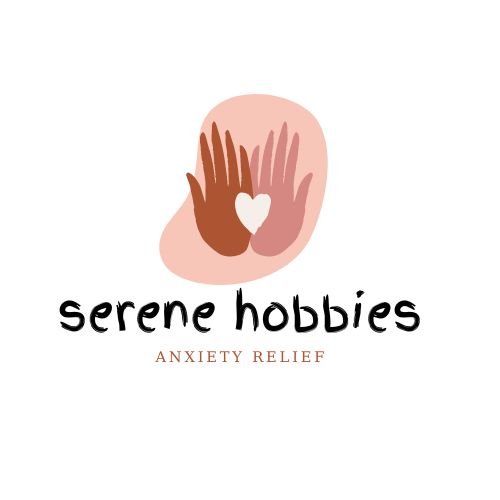
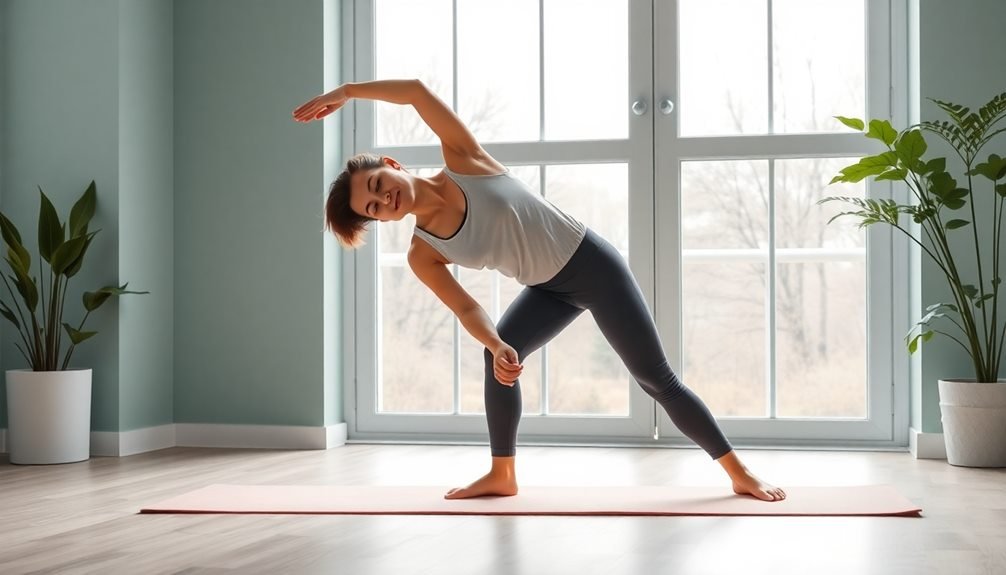
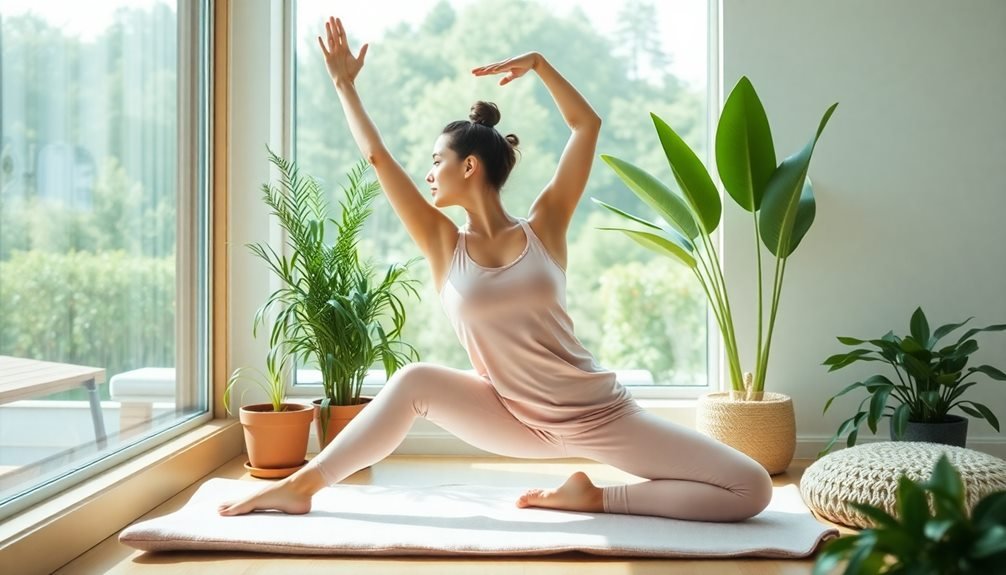
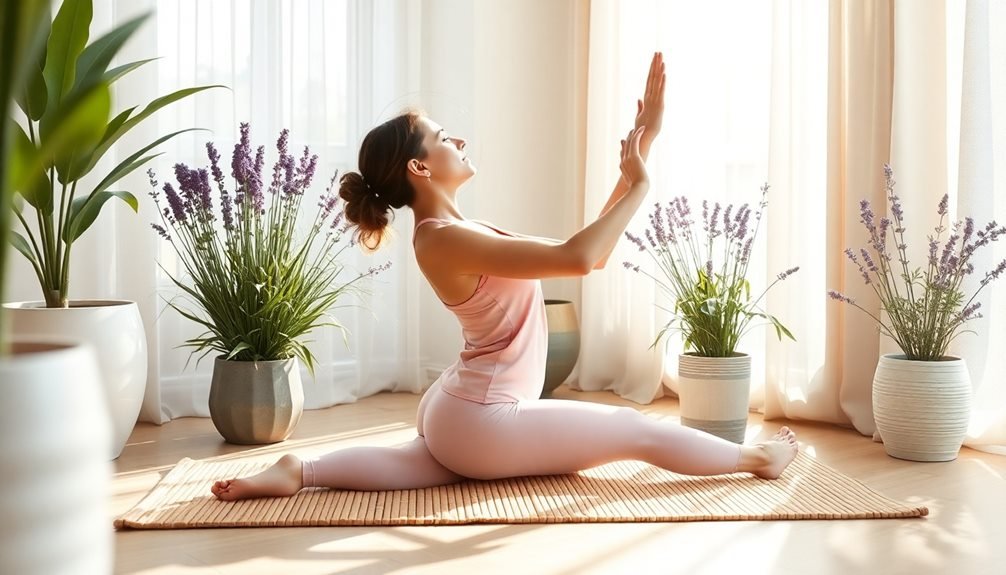
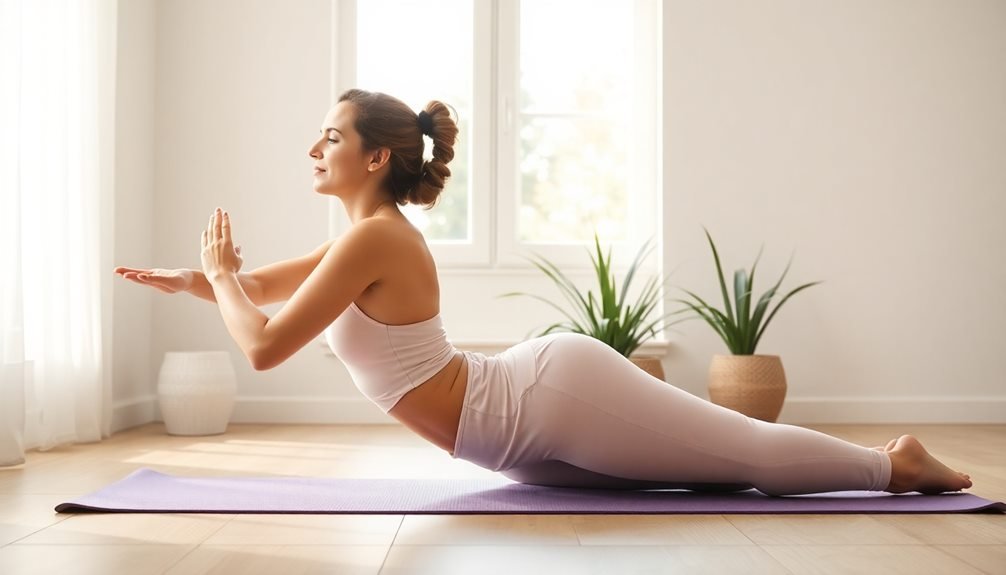
Leave a Reply